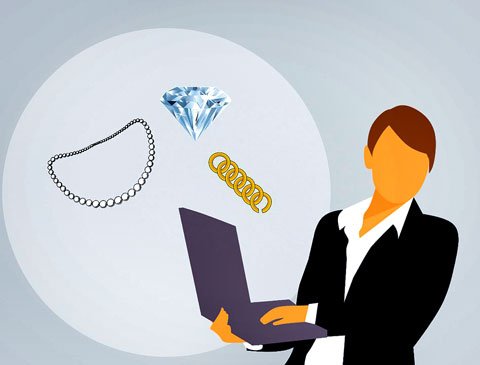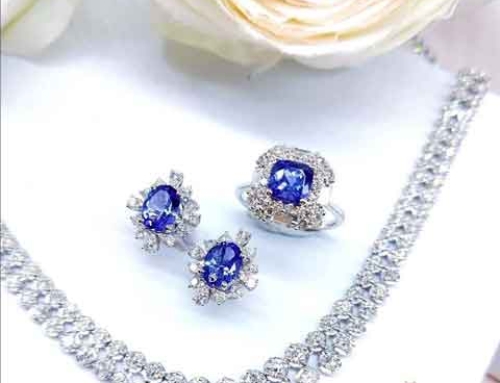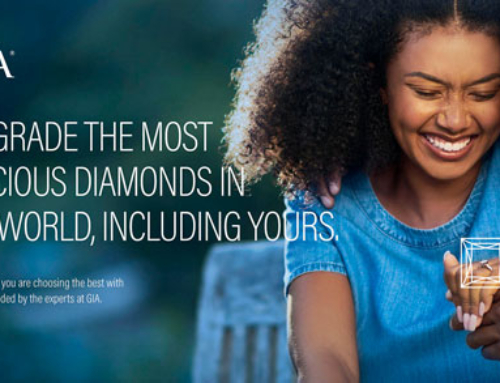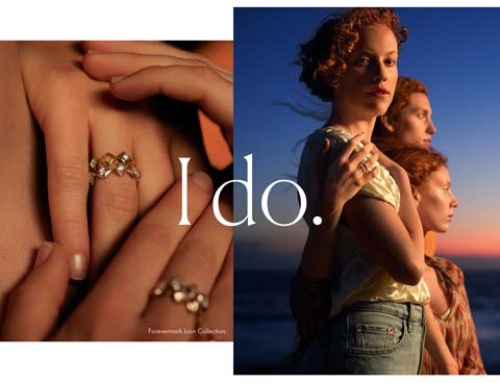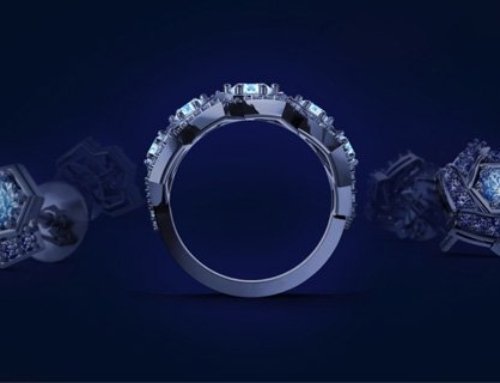If you want to earn money with diamond jewellery in the future, you have to win over consumers under 40 who are used to technology. The industry agrees on this. A diamond startup in Antwerp has geared its entire business model to this and is thus trying to shake up the branch.
Gary wears a short-sleeved white shirt, blue jeans and glasses. He sits on the seventh floor of an inconspicuous house in the “Diamantwijk”, the diamond quarter in the immediate vicinity of Antwerp Central Station. The 49-year-old presses two golden ear studs into a wax-like, warmed-up mass. Two diamonds are ready in a black bowl. Gary is a diamond setter at the startup Baunat. He has to fix the small stones, worth several thousand euro each, safely and without damage in the golden “arms” of the plug.
Meanwhile, two floors below, colleagues are checking the incoming goods. Using powerful magnifying glasses, they search for the identification numbers engraved on the diamonds that have arrived, which are invisible to the naked eye. They then compare these with the certificates of origin supplied, which confirm that they are not so-called conflict diamonds.
Diamond City Antwerp
So far, so usual for a diamond jeweler in Antwerp. The city located in the north of Belgium at the Schelde does not only have the second largest harbour of Europe, but is still considered as the actual capital of the diamonds.
The diamonds, which originate mainly from mines in Russia, Canada, Botswana, Australia, Congo-Kinshasa, South Africa and Angola, are cut and polished in India due to the lower labour costs. Nevertheless, 1.600 registered traders still buy and sell around 86% of all unprocessed diamonds and 50% of all polished diamonds in Antwerp. Belgium exported 12.7 billion € worth of such stones in 2018, which corresponds to 4.3% of the gross domestic product.
Diamond startup does 70 percent of turnover online
But Baunat, short for “Beauté naturel”, is not as “normal” as it might seem at first glance. The Belgian start-up, founded in 2008, generates 70% of its turnover of €9 million on the Internet, while the corresponding industry average, according to experts, is 10%. Baunat does not own any shops in the true sense, but operates nine “showrooms”. In addition to those in Antwerp’s diamond quarter, these are located in Paris, Geneva, Zurich, Amsterdam, Düsseldorf, Nice, Hong Kong and Mumbai.
In the online shop, for example, you can buy a ring made of white gold with a 5 carat “fancy intense” pink drop-shaped diamond for almost € 3 million with just a few clicks. The free and insured delivery is promised within seven working days, including a 30-day return policy. However, the goods must be paid for in advance. While this item is probably primarily for advertising purposes, the product most frequently bought by typically male customers is an engagement ring with diamond, a so-called solitaire, for several thousand euro.
Three trends in the diamond industry
With this offer Baunat tries to take into account the latest developments in the industry. Three trends are currently shaping the industry, as the consulting firm Bain & Company states in a report on the diamond industry 2018 written with the Antwerp World Diamond Centre.
First: more youth
First of all, the composition of the clientele is changing, and so are their preferences. The under 40-year-olds (“Millennials”) and under 23-year-olds (“Generation Z”) together accounted for almost two-thirds (64%) of the global population in 2017, and they are increasingly gaining purchasing power. According to a market report by De Beers, the Millennials will have an annual income of $4,000 billion in 2030 and will inherit $30,000 billion over the next three decades. De Beers is the market leader, producing one in three rough diamonds worldwide, controlled by Anglo American, a British-South African mining group, and also active in jewellery retailing.
The younger customers are always online and want to be able to do this immediately when they want to buy something, writes De Beers CEO Bruce Cleaver in the report. There is no need to prove to young people that diamonds are the perfect symbol of love. But the way consumers shop is changing. You can’t just put the products in the window, sit back and wait, Cleaver said.
More than a quarter of diamond jewellery sales (27%) in the USA, China and Japan are still made through engagement and wedding products. These three countries accounted for the bulk of the diamond jewellery market in 2017, accounting for 71% of global sales of $82 billion. In these regions, the average age at first marriage is between 24 and 30 years. These are the millennials.
Second: more online sales
And they are hardly afraid to buy expensive goods on the Internet. While the share of online sales in the luxury goods industry was still 1% in 2008, it was 10% in 2018 as mentioned above. Experts expect to see growth to 25% by 2025.
The number of newly opened luxury shops is slowly decreasing, writes Bain partner Federica Levato in a corresponding study. This will lead to consolidation. Brand companies should think about their physical sales channels and develop them from points of sale to contact points. With the new technologies, the customer must be offered new experiences in the store, Levato continues. These are changes that require investment and represent a major challenge, especially for small, traditional quarter jewelers.
This is probably one of the reasons why the importance of brands in the diamond business has increased recently. According to diamond startup Baunat, only 10% of diamond jewelry was sold under a brand in 2003, while the rest – as in traditional stores – was sold without. By next year, the share of brands is expected to rise to 30-40%.
Third: more laboratory grown stones
In addition to digitalization and the growing importance of the younger generations, Bain sees a third important trend in the emergence of diamonds “grown” in the laboratory. This trend gained additional momentum last year when De Beers entered the segment with a concept called Lightbox Jewelry. Each carat costs about $800 to represent the linear production costs of the laboratory stones. This is well below the price of several thousand euros for one-carat natural diamonds. Another advantage of the self-made stones is that although they are not rare, their origin can be determined beyond doubt. This is more difficult with the natural counterparts despite the relevant certificates.
Baunat does not want to have anything to do with laboratory diamonds. The company founders Stefaan Mouradian and Steven Boelens both came from Blue Star Diamonds, an Indian diamond company. Previously, Mouradian had also worked for the Dutch bank ABN Amro. The two found that there was virtually no brand company selling diamond jewellery with a focused online business model. According to Baunat, the American pioneer Blue Nile, for example, is positioned as an online retailer where customers can assemble their own products, while Baunat is a brand with its own collections.
“Not everyone can buy in India”, says diamond startup director
Another distinguishing feature of diamond startup Baunat is its procurement. Due to its contacts in the market-dominating polishing industry in India, the company purchases directly on site. However, this does not happen until Baunat’s customer has paid for the diamond in advance. In this way, the company can also significantly reduce inventory costs.
In the conversation, Baunat Managing Director Mouradian pulls his smartphone out of his trouser pocket and shows a picture of a large Indian family. The 56-year-old Belgian points to various people and says that he can call this or that person if problems arise. Not everyone obtains diamonds in India. The business is based on trust and personal relationships.
This allows Baunat to skip the intermediaries in the traditional diamond value chain and offer its own products at lower prices.
Expensive growth for this diamond startup
Diamond startup Baunat now has 30 employees. In the past five years the company has grown strongly, on average by 35% each year. But the rapid expansion and development of the brand came at a price. The company is not yet profitable, but has received fresh equity from its shareholders time and again. The last capital increase took place in spring. The first profit is planned for 2020, with a turnover of € 15 million.
Mouradian explains that it is able to finance further internal growth. However, he would rather increase the speed of growth even further by joining forces with a large group in the industry. Inquiries had already been made in this regard, without having gone deeper. He still sees a lot of potential for his company. Recently, for example, the product range has been expanded to include watches and higher-priced jewelry, and diamonds have been added as investment objects.
There are probably numerous competitors who are now present on the Internet and very active. In addition to companies such as Gemmyo, Celinni and Mauboussin from France, the big brands such as Cartier, Harry Winston from the Swatch Group and Tiffany & Co., are also trying to establish themselves in the digital age. For Mouradian, however, the fact that the entire business model is geared to the Internet is to his company’s advantage. In contrast to the established providers, you don’t have to carry an “analog” legacy or undergo a corresponding cultural change.
Overall, the industry is likely to do everything in its power to catch up with online pioneering companies such as Baunat and Blue Nile on the Internet. In the future, diamond jewellery will either be sold online, or at least sales will be influenced by the Internet.


